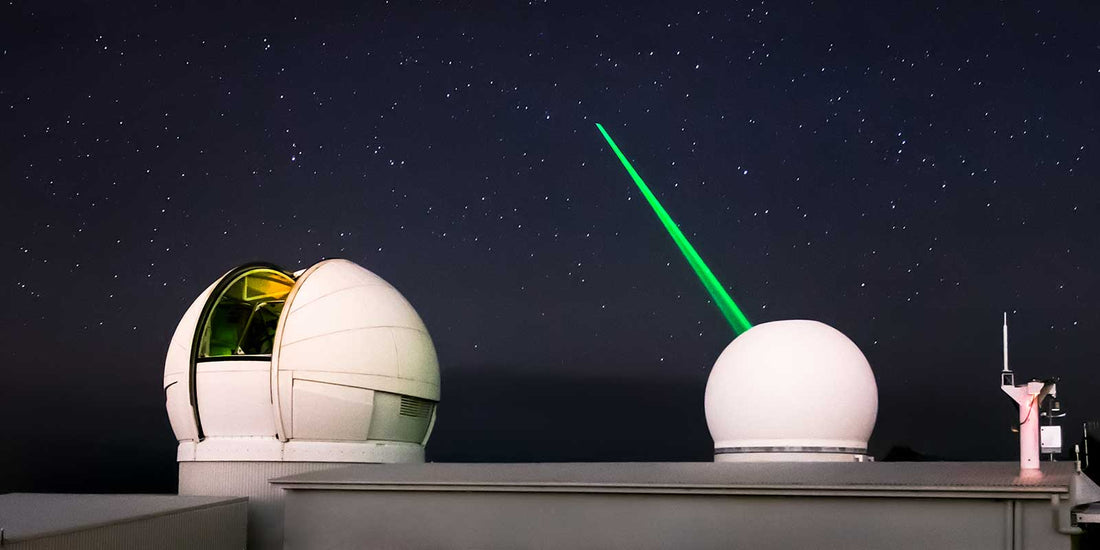
Aussie Scientists Plan To Fire A Freakin’ Laser Beam At Space Garbage
Share
Aussie scientists at the Australian National University (ANU) have pushed a technique that helps telescopes see objects in the night sky more clearly one step further. And the result is laser beams that can go toe-to-toe with pesky space rubbish.
The past seven years have been dedicated to turning Mt Stromlo Observatory in Canberra into a laser firing base. And the collaborative Electro Optic Systems (EOS) CEO, Professor Craig Smith, explains scientists have invented a photon pressure laser that "is able to nudge space debris objects around, change their orbits."
An Australian National University (ANU) team, together with colleagues from the EOS have developed the optics that focus and direct the laser. This includes cooperation with RMIT University, Japan and the USA as part of the Space Environment Research Centre (SERC).
And now, a world-first laser designed to shunt dangerous space debris out of orbit has been developed.
Only Nerds Care About Space Garbage, Right?

Wrong.
Low-orbit garbage sucks for everyone.
Space junks sucks because large uncontrolled pieces can reenter the atmosphere to reach Earth's surface, creating risk to the population on the ground. If the situation with space junk became worse, and the density of low-orbit junk increased, it will be increasingly hard to launch new satellites or even view the night sky with advanced telescopes.
Space debris is usually one or more of the following:
- Derelict spacecraft and upper stages of launch vehicles
- Carriers of multiple payloads
- Debris released during spacecraft separation from the launch vehicle
- Spacecraft or upper stage explosions or collisions
- Solid rocket motor effluents
- Tiny paint flecks released by thermal stress or small particle impacts
It's estimated there's about 130 million shreds of trash in space which are either fragments of spacecraft, nuts, bolts, dead satellites, or even urns containing the ashes of people fired into space.
Of these, there are more than 22,000 objects larger than 10cm currently being tracked by the U.S. Space Surveillance Network. While 1,000 of these are operational spacecraft, that means 21,000 pieces of debris are zooming around Earth at 29000 km/h that can cause catastrophic damage to spacecraft.
And what's more, debris in a "graveyard orbit" is expected to stay there for about 4,000 years.
How The Laser Goes Pew Pew

Thankfully, the researchers - using their adaptive optics technology - have increased detection, monitoring and safe transportation of space debris in order to create a new 'guide star' laser, which clears the haziness caused by turbulence in the atmosphere, more efficiently.
In addition to providing vital services around the globe, space infrastructure worth more than $AU900 billion is subject to a major threat, space debris. With laser guide stars, this infrastructure can finally fight back.
The latest guide star laser technique that EOS designed will now be commercialised. This could also be integrated as part of an instrument kit that would facilitate high-bandwidth ground-to-space communications.
Tracking space debris is traditionally performed by laser beams that emit radio frequency energy instead of observable light.
On the other hand, the new laser guide star, which is attached to a telescope, fires an observable beam into the night sky in order to create what is essentially an artificial star to accurately measure light distortion between Earth and the object in space.
In the first instance, scientists would be able to detect and track identified objects through the use of low-powered lasers to image space matter in close proximity to the planet.
This guidance laser allows adaptive optics to hone images of space debris. Also, it can direct a more powerful infra-red laser beam through the atmosphere to provide accurate monitoring of debris or even move them out of orbit so they won't get into collisions with other debris and eventually burn up in the atmosphere.
"With the laser tracking systems we track objects and predict collisions to high accuracy," Professor Smith said. A laser could be used to alter the orbit of a piece of space debris if it looked like it was headed towards a collision with a piece of another space debris. The next step would be to keep "ramping up the power to bigger and bigger lasers. Then we can start moving it enough to what we call 'de-orbit' the satellite by reducing its velocity enough that it starts to change orbit height. It eventually hits the atmosphere and the atmosphere takes over and drags it and burns it up."
It’s a great time to be a laser nut. And we could be seeing a laser blast old nuts out of Earth’s orbit. What a time to be alive.
#Space_Aus




